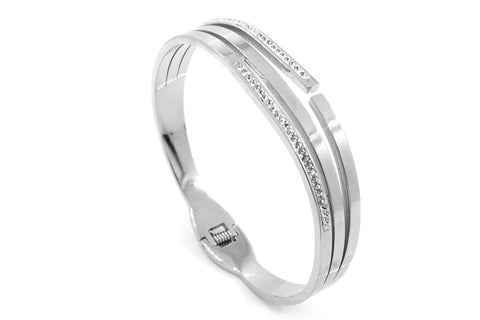We get a lot of questions about rhodium plating. What is it? What are the benefits? How long does rhodium plating last? This guide will explain everything you need to know about this jewelry maintenance method. We’ll also share the benefits and downsides of getting items rhodium-plated, as well as talk about the life expectancy of rhodium-plated jewelry. Let’s get started!

(Pixabay / 947051)
What is rhodium plating?
Rhodium plating is a process where rhodium (a white metal) is applied in a thin layer to a piece of jewelry to keep it from tarnishing. It increases the jewelry’s resilience from scratches and adds an elegant, reflective white finish. The technique is most commonly applied to white gold jewelry but may also be used for silver and other precious metals. You may also hear it referred to as rhodium dip or rhodium flashing.
Rhodium is a precious metal that belongs to the platinum family, which includes ruthenium, iridium, platinum, osmium, and palladium. An ounce of this metal usually costs between $2,500 and $3,000, but prices can fluctuate widely with changing market conditions. Aside from being one of the most expensive precious metals in existence, rhodium has incredibly high light reflective traits and is extremely resistant to corrosion.
How to perform rhodium plating?
The first step in the plating process is to make sure the jewelry is completely clean before rhodium is applied. It’s not enough to simply wash the jewelry in a bowl of water. Even the slightest scrap of dirt will prevent the rhodium coating from sticking to it. For these reasons, the thorough cleaning of the jewelry is necessary.
Some jewelers will even consider electrocleaning. This involves polishing the jewelry to eliminate any visible scratches, transferring it to an ultrasonic unit, taking it out for power steaming, and rinsing the jewelry in an electrocleaning base. All of the steps are effective and ensure the jewelry is as clean as it can possibly be. The most critical aspect of electrocleaning is that anything that could stop the rhodium coating from attaching is removed.
What’s the lifespan of rhodium plating?
It depends on the type of jewelry the rhodium is applied to and the amount of friction the jewelry gets. For necklaces and earrings, rhodium plating may last forever. But for essentials that are worn daily and get a lot of wear and tear, rhodium plating may start coming off after a year. For example, if you have a ring that you wear daily, the plating may wear off due to hand-washing, dish-washing, friction from gripping things, etc.
In addition, a torch flame can also prematurely reduce the lifespan of rhodium plating. Granted, you may not be doing much with a torch flame, but if a jeweler tries to repair your jewelry or other ornament and needs heat to perform the job, they may use a torch. Though this may be helpful with the repair, it could compromise the rhodium plating.
The user comes to know when the jewelry needs to be replated. The metal color starts to tarnish, revealing the original yellowish hue. This becomes apparent at the bottom of the jewelry where most pieces receive the most wear and tear.
When it comes to replating, most jewelry pieces are eligible, although two-toned pieces are more expensive to replate because the work has to be performed by hand. Prices vary based on the thickness of the rhodium plate; the thicker the plating, the higher the quantity of the metal used, and the more expensive the replating process is. Consumers should choose thicker layers for everyday items as the one-time expense will pay off with greater long-term durability.
Benefits and drawbacks of rhodium plating
There’s no questioning the benefits of rhodium plating. However, the process is also not without its fair share of weaknesses. The most important of these are discussed below.
Benefits
The key benefit of rhodium plating is longevity. When used to plate a piece of jewelry or another piece of metal, it adds resistance against scrapes and scratches. Another advantage is that the precious metal is hypoallergenic. It is devoid of nickel as well as of other harmful materials commonly applied to jewelry. Hence, it’s unlikely to aggravate skin allergies. This is a big deal for people who may have trouble finding jewelry that won’t leave them with an itchy, red rash.
Besides all that, rhodium plating will also extend the visual appeal of a jewelry piece by reflecting light. When this happens, the coat makes the jewelry shine brighter, while slowing tarnishing and minimizing the appearance of blemishes.
Drawbacks
The biggest disadvantage of rhodium plating is its cost. Because rhodium is two times more expensive than gold, applying a rhodium coat to jewelry can put some stress on your wallet. Even rhodium plating a small piece of jewelry can cost you upwards of $100. And because rhodium wears off after a while, you’d need to spend another $100+ to have your jewelry replated.
Also, rhodium plating is less common in small suburbs. Independent jewelers don’t always offer rhodium plating. So you might have to take your business out of town. Some jewelers offer a mailing option, but many are reluctant to use it for fear of their collections being lost.
Final verdict
Rhodium plating is an effective way to increase the aesthetic appeal of your jewelry while protecting it from blemishes and scratches. Though not strictly required, it’s recommended for high-end pieces that you wear on a regular basis. Wedding rings, for instance, are often plated with a rhodium solution.
For hobbyists, jewelry dealers, or jewelry repair specialists, you can order our Jewel Master Pro HD Plating Kit for applying rhodium and other plating finishes. These convenient, bench-top kits offer professional results at an affordable price.
